
|
|
|
|
|

|
Archive for the ‘Sierra’ Category
Tuesday, July 5th, 2022
Version 2.7.3 of App Tamer is now available, fixing a couple of problems.
First, my apologies to folks using versions of macOS older than Big Sur: Changes in the last App Tamer update tightened up the spacing of its menu bar icon to comply with modifications Apple made to Monterey and Big Sur. Unfortunately, it also did that on pre-Big Sur systems, often making its icon too close to adjacent ones in the menu bar. I’ve fixed that in 2.7.3.
Second, internal changes that Apple made in macOS resulted in App Tamer reporting the CPU usage of one particular process – kernel_task – incorrectly. App Tamer would show either zero or astronomical values for kernel_task’s processor use, neither of which was correct. In App Tamer’s defense, the system’s approved public API was supplying those numbers and it dutifully reported them without prejudice. Some hunting around in the macOS source code (thank you Apple for making darwin Open Source!) revealed an alternate method that correctly reports the CPU usage of all processes, including kernel_task. So that fix is now available in App Tamer, making it a reliable source of CPU information for all processes again.
As usual, release notes and download links are on the App Tamer release page, or if you’re already using App Tamer, just choose “Check for Update” from its menu. This update is free if you’ve already purchased an App Tamer 2.x license.
Posted in App Tamer, Big Sur, Catalina, El Capitan, High Sierra, Mojave, Monterey, Sierra, Ventura, Yosemite | No Comments »
Tuesday, October 16th, 2018
Jettison 1.7.1 is available, bringing fixes for a couple of simple problems and one complicated one.
Simple stuff:
The previous release of Jettison didn’t correctly show that it was licensed when you looked in the About box after importing a Mac App Store license. This was understandably very confusing to those of you that followed the instructions for upgrading in the FAQ. It now correctly shows “Licensed to: Mac App Store User” (since Apple doesn’t provide a way for us to get your name or Apple ID from your license) and removes the “License” item from its menu.
Also, there were occasions when all of the items in Jettison’s menu would become grayed out. This turned out to be caused by its error window getting stuck behind an application that was in Full Screen mode. It was patiently waiting for you to respond to an error message you couldn’t see – definitely not very helpful. That’s been fixed now.
Messy issues with Power Nap and Wake for Network Access:
When Power Nap or Wake for Network Access are turned on in your Energy Saver prefs, macOS may wake from sleep in ‘dark mode’ – which means it wakes from sleep, but never turns on the display. When this happens, it doesn’t let most applications – including Jettison – know when it wakes up or goes back to sleep. That means that Jettison can’t mount or eject your disks as it’s supposed to.
This would all be well and good if this temporary wakeful state mounted your disks, did its thing (like a Time Machine backup), ejected the disks and then went back to sleep. Unfortunately, while it seems to (mostly) work with Time Machine disks, if other drives get mounted during dark wake, you’ll often see a “Disk not ejected properly” error for them when you return. macOS can’t always manage the mounting and ejecting of disks correctly, even when it’s all by itself in a dark room.
Jettison 1.7.1 solves this problem by refusing to let macOS mount any non-Time Machine drives during a dark wake. This should take care of the disk errors (and associated possibility of data corruption) while still allowing you to use Power Nap and Wake for Network.
On the outside chance that you’re actually getting error messages for your Time Machine drive too, you can launch Terminal and run this command:
defaults write com.stclairsoft.Jettison disableTimeMachinePowerNap 1
That will tell Jettison to prevent your Time Machine drive from being mounted during dark wakes – with the obvious consequence that Time Machine can’t run Power Nap backups while your machine is sleeping. It’s a compromise, but at least it’ll ensure that your backups don’t get corrupted.
You can see the full change history and download Jettison 1.7.1 from the Jettison release page.
Posted in High Sierra, Jettison, Mojave, Sierra, Tips | No Comments »
Wednesday, January 10th, 2018
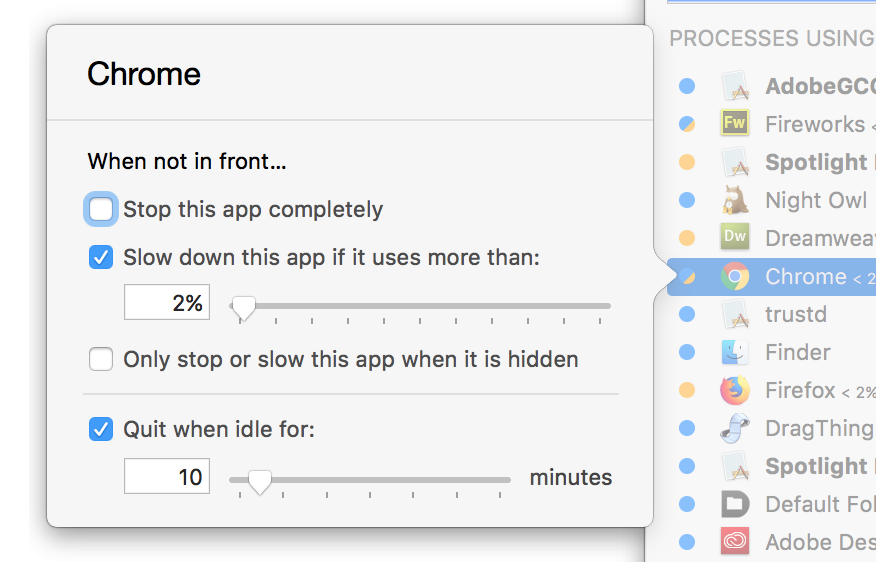 Version 2.3.4 of App Tamer is now available, adding an extra checkbox to the settings for each application. You can now have App Tamer automatically quit an app after it’s been unused for a certain amount of time – handy for those one-shot utilities like password managers, image converters, Contacts, etc that you look at quickly and then accidentally leave open. Version 2.3.4 of App Tamer is now available, adding an extra checkbox to the settings for each application. You can now have App Tamer automatically quit an app after it’s been unused for a certain amount of time – handy for those one-shot utilities like password managers, image converters, Contacts, etc that you look at quickly and then accidentally leave open.
This version also improves App Tamer’s ability to control the CPU usage of applications that employ helper processes to do some of their work. This includes web browsers, Spotlight, virus scanners and backup utilities, among other apps. While App Tamer’s management of CPU usage is always going to be approximate (because it doesn’t know the inner workings of every app), it now keeps an app’s average usage much closer to the limit you’ve specified.
Head over to the App Tamer release page to see the full list of changes and to download a copy of version 2.3.4!
Posted in App Tamer, High Sierra, Sierra | No Comments »
Tuesday, November 14th, 2017
This talk by Tim Standing (one of the developers behind SoftRAID) is an excellent analysis of APFS:
http://docs.macsysadmin.se/2017/video/Day3Session4.mp4
He has some very interesting points and conclusions – one of which is to never install APFS onto non-SSD (traditional spinning-platter) drives. The revelation that a major change was made to APFS very shortly before its release is also a little troubling, but at least that explains the current lack of documentation :-/
Thanks to Ronald Leroux for bringing this to my attention.
Posted in Code, Development, High Sierra, Sierra | 1 Comment »
Thursday, May 11th, 2017
TLDR; Get Default Folder X 5.1.5 here. Default Folder X now shows its bezel around minimized Save dialogs and fixes crashes and compatibility problems, especially with old Carbon apps like Office 2011 and Adobe Creative Suite 6. It also addresses issues with particular shortcut key combinations and works better with Spaces.
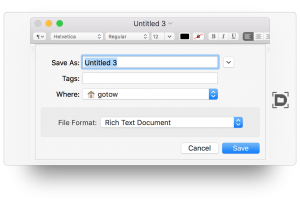 For Those That Want Details: ‘Minimized’ Save As dialogs have been a problem for Default Folder X for some time. Because of the way macOS El Capitan and Sierra work, DFX can’t provide all of its features in a Save dialog if there’s no list of files and folders. Up until now, Default Folder X would simply not appear next to minimized Save dialogs. This caused confusion, with some people thinking that DFX wasn’t working at all, when in fact it just couldn’t do anything in that particular situation. For Those That Want Details: ‘Minimized’ Save As dialogs have been a problem for Default Folder X for some time. Because of the way macOS El Capitan and Sierra work, DFX can’t provide all of its features in a Save dialog if there’s no list of files and folders. Up until now, Default Folder X would simply not appear next to minimized Save dialogs. This caused confusion, with some people thinking that DFX wasn’t working at all, when in fact it just couldn’t do anything in that particular situation.
I kept revisiting this issue over and over again to see if I could find some sort of technical solution that’d let me get Default Folder X working in this configuration. Alas, it’s not to be – there are some fundamental limitations that prevent Default Folder X from working. So in version 5.1.5 I’ve put together a simple bezel that comes up around minimized Save dialogs and offers a single option: expanding the dialog so that Default Folder X can provide all of its features. It isn’t ideal, but it’s less confusing than just having Default Folder X missing in action when you click the minimize button in a Save dialog.
In addition to this change, Default Folder X 5.1.5 addresses a number of compatibility and stability issues (ie. bugs). I’m actually very happy to have found the source of a recurring crash that I’ve never been able to reproduce. Crash logs have been trickling in, but none of them actually pointed to the underlying problem. I’ve now found a bug that appears to be the cause of those crashes, and have also addressed bunch of other issues that have come up since the last release.
A change list and download links are available at http://www.stclairsoft.com/DefaultFolderX/release.html
Posted in Default Folder X, Sierra | 1 Comment »
Wednesday, April 5th, 2017
 With today’s release of App Tamer 2.3.2, you can now resize App Tamer’s window to display more processes on larger monitors. This version also fixes a couple of nagging bugs that could cause App Tamer to think it was slowing down a background process when it actually wasn’t. If you’ve ever looked at the process list and seen a background daemon pegged at 100% even though App Tamer shows its yellow “slowed down” icon next to it, this release will fix that 🙂 With today’s release of App Tamer 2.3.2, you can now resize App Tamer’s window to display more processes on larger monitors. This version also fixes a couple of nagging bugs that could cause App Tamer to think it was slowing down a background process when it actually wasn’t. If you’ve ever looked at the process list and seen a background daemon pegged at 100% even though App Tamer shows its yellow “slowed down” icon next to it, this release will fix that 🙂
The 2.3.2 update is free for licensed users of App Tamer 2.x. You can see the detailed release notes and download it on the App Tamer release page.
Posted in App Tamer, Sierra | No Comments »
Wednesday, March 1st, 2017
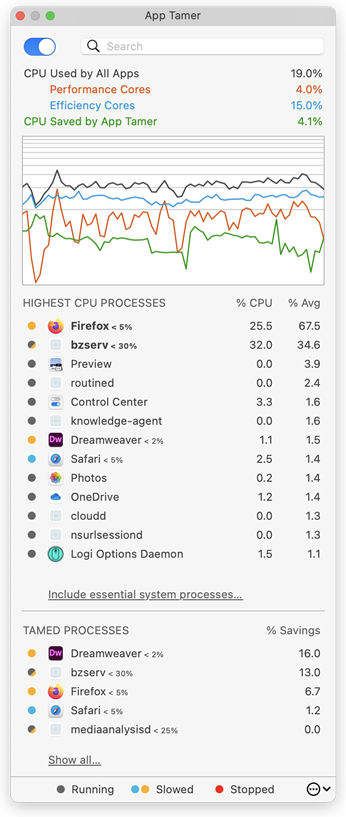 Version 2.3.1 of App Tamer fixes several bugs in our CPU- and battery-saving application, as well as more smoothly supporting Spotify. If you’ve got App Tamer set up to manage Spotify’s CPU usage, it will not slow it down or stop it while Spotify is playing music. This prevents your music from stuttering or going completely silent – generally a good thing 🙂 Version 2.3.1 of App Tamer fixes several bugs in our CPU- and battery-saving application, as well as more smoothly supporting Spotify. If you’ve got App Tamer set up to manage Spotify’s CPU usage, it will not slow it down or stop it while Spotify is playing music. This prevents your music from stuttering or going completely silent – generally a good thing 🙂
You can find more details and download links on the App Tamer Release page. We recommend that all App Tamer users update even if you don’t use Spotify because the bug fixes are important.
And on the topic of App Tamer, I was remiss in my duties – I didn’t blog about the release of version 2.3, even though it delivered a couple of very significant changes. The most obvious one is a user interface overhaul that brings App Tamer up to snuff with the flat, white look that’s all the rage (check it out over on the right there). The preferences have also been split among multiple tabs to better organize them, and hopefully make all the settings a little less intimidating.
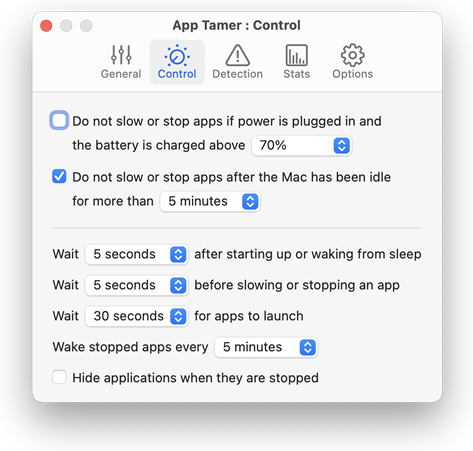
A more interesting, though much less visible addition is App Tamer’s new “CPU hog detection” feature. In the “Detection” tab of the preferences, you can set a limit to how much CPU any application should use. If any app uses that much CPU for longer than a time you specify, App Tamer will pop up a warning to let you know that something’s amiss, and will give you several options.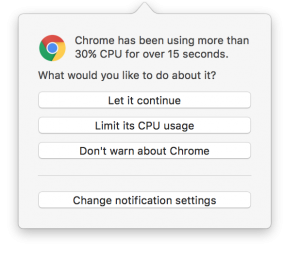 If you’re on a laptop, this is great because it lets you know before the CPU hogging app drains your battery down to nothing and you realize that you left your power adapter under the couch at home. If you’re on a laptop, this is great because it lets you know before the CPU hogging app drains your battery down to nothing and you realize that you left your power adapter under the couch at home.
And of course there are a whole bunch of little fixes and improvements rolled into versions 2.3 and 2.3.1 as well. It’s worth the trouble to download, especially if you’ve already bought a license for App Tamer 2 because these updates are free.
Posted in App Tamer, Sierra | No Comments »
Tuesday, February 28th, 2017
This is information I originally posted back in 2009, but here we are 6 macOS versions later and it’s still relevant – and people are still asking for it.
Below are details on how to create a “Move Items” contextual menu item in the Services menu in the Finder (see the picture below).
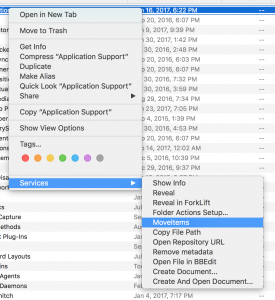
It pops up a file dialog to let you specify where you want to move the selected items, which then allows you to use Default Folder X, giving you access to all of your Favorite and Recent folders, Finder-click, etc.
TL;DR: If you just want to get things to work, there’s a link at the bottom to download an already-built Automator workflow.
Contextual menu items are added by making a Workflow in Automator and saving it as a Service. You start by running the Automator application (it’s in your /Applications folder), creating a new Workflow, and setting it up as shown in the (old) screenshots below:
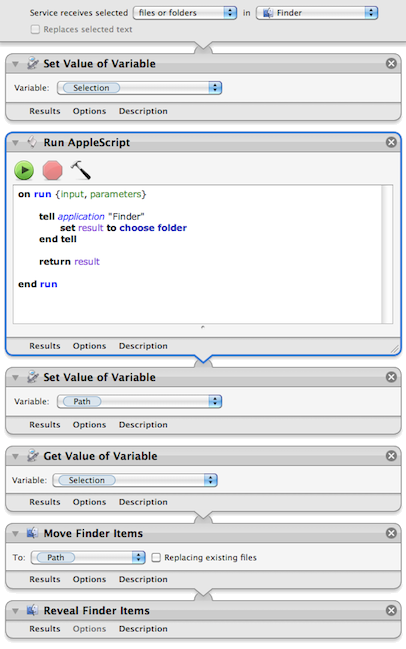
If you’re experienced with Automator, you’re probably asking: Why go to the trouble of creating variables instead of just using the “Move Finder Items” action by itself? I’m glad you asked! The reason is that I want to bring up a file dialog to specify the folder where I want the items to go. There’s not a clean way to have the “Move Finder Items” do that every time. You can change its options to “Show this action when the workflow runs” but you still have to click on it every time you use it to ask it to show a file dialog. If you use Default Folder X to enhance your Open dialogs, it’s faster to just have the dialog pop up and then go where you want to with DFX.
So in the image above, the workflow puts the current Finder selection into the “selection” variable. Then it uses AppleScript to bring up a file dialog to ask for a folder, which it stores in the “path” variable. And finally, it uses the Move Finder Items action to do the work. Not too much more complicated, and it speeds up your workflow considerably if you’ve already got DFX installed so the Open dialogs are smart.
For you Automator programmers, note that some of the actions shown in the workflow do not take inputs. I did this by control-clicking on the action (“Get Value of Variable”, for example) and choosing “Ignore Input” from the contextual menu. If you don’t do this, Automator will actually add the input from the previous step to the next one, which is definitely not what you want in this case.
Oh, and if you just want the automator workflow file so you can add it to your own system, you can download it here:
https://www.stclairsoft.com/download/MoveItems.zip
If you need more help with Automator and Services, Sal Soghoian has some good information and tutorials here:
https://www.macosxautomation.com/services/learn/
(Once you’ve gotten through the first few steps of the tutorial, you should be able to just replicate the picture above to make the Move Items service yourself).
Posted in Code, Default Folder X, Sierra, Tips | 2 Comments »
Friday, December 30th, 2016
So I’ve noticed in Sierra that some of its “helper processes” (apps that run in the background to do various tasks) will occasionally start using 100% CPU for no reason. In particular, I’ve seen the com.apple.appkit.xpc.openAndSavePanelService process stay pegged after a file dialog is done – it just sits there and consumes CPU while doing nothing. Quitting the app that was showing the file dialog will stop the CPU-hogging, but it otherwise continues indefinitely.
I’ve been wondering if this might actually be the source of the much-talked about Consumer Reports findings that the new MacBook Pros have very inconsistent battery life. Their results varied widely from test to test (on the same computer) – maybe one of the WebKit helper processes was just flipping out once in a while due to some underlying bug in Sierra’s interprocess communication or process management services.
 While that’s just my own random speculation, the issue of processes running amok seems to be a recurring annoyance to some folks. To help you detect this sort of stuff, I’m adding an option in App Tamer to notify you if a process starts consuming excessive CPU time. If it does, it gives you the options shown in the screenshot. While that’s just my own random speculation, the issue of processes running amok seems to be a recurring annoyance to some folks. To help you detect this sort of stuff, I’m adding an option in App Tamer to notify you if a process starts consuming excessive CPU time. If it does, it gives you the options shown in the screenshot.
Can’t hurt, right? Shoot me an email (AppTamer at stclairsoft dot com) if you’re interested in trying it out and doing a little testing for me.
– Jon
Posted in App Tamer, Development, Sierra | 1 Comment »
Tuesday, December 13th, 2016
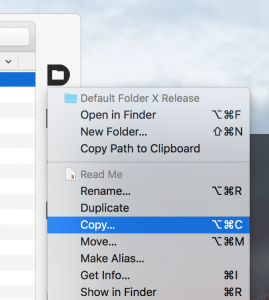 Default Folder 5.1 is now available, and includes a long list of changes. Key among them are new commands that let you copy, move, and make aliases to files and folders right in your file dialogs. Want to save a copy of that file to your Desktop folder before you make changes to it? Just use the Copy command in Default Folder X’s toolbar and choose the Desktop as its destination. Default Folder 5.1 is now available, and includes a long list of changes. Key among them are new commands that let you copy, move, and make aliases to files and folders right in your file dialogs. Want to save a copy of that file to your Desktop folder before you make changes to it? Just use the Copy command in Default Folder X’s toolbar and choose the Desktop as its destination.
Default Folder X will now also mirror all of your favorite folders, recent folders and recent files using aliases in your Library folder. If you use another file management utility like Path Finder, Alfred, LaunchBar, etc for quick access to files and folders, you can connect it with your Default Folder X data by pointing it to these folders:
HOME/Library/Favorites/
HOME/Library/Recent Folders/
HOME/Library/Recent Files/
There are other convenient additions as well, like the ability to change the creation and modification dates of files and folders, and Command-selecting an item from a Default Folder X menu to reveal it in the Finder.
And as usual, there are also compatibility improvements and bug fixes – quite a lot of them this time. While Default Folder X has been performing very well for nearly everyone, the automated crash logs have uncovered a handful of infrequent but persistent problems. I’ve done a lot of stress-testing and debugging to ferret them out, making this release more reliable – and thereby less annoying for both you and me 🙂
For a complete list of changes, bug fixes and download links, check out the Default Folder X Release page!
Posted in Default Folder X, Sierra | No Comments »
|

|
|

|
|


 Version 2.3.4 of App Tamer is
Version 2.3.4 of App Tamer is 
 With today’s release of
With today’s release of  Version 2.3.1 of
Version 2.3.1 of 



